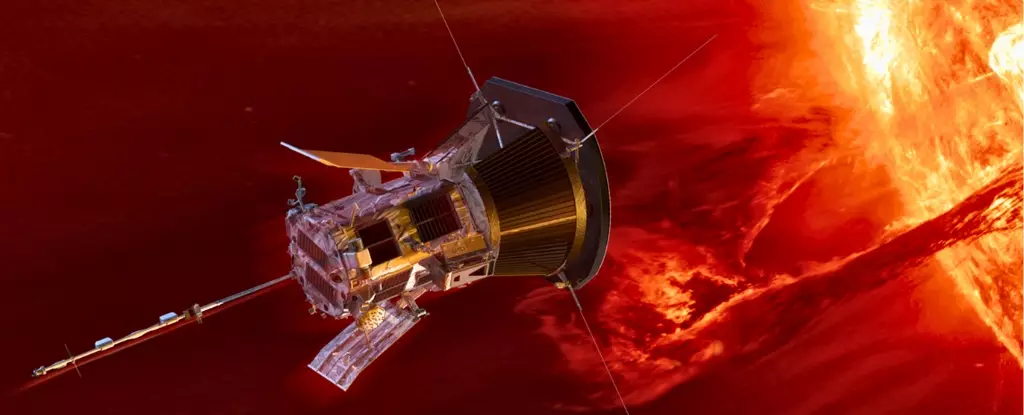Launched in August 2018, NASA’s Parker Solar Probe (PSP) embarked on an unprecedented mission to unveil the mysteries of our nearest star, the Sun. This innovative spacecraft is not just breaking records; it’s redefining our understanding of solar physics and the dynamics of space weather. With its highly elliptical orbit, which includes gravity-assist maneuvers around Venus, the PSP has successfully dove into the Sun’s outer corona multiple times. This daring venture allows scientists to glean critical insights into solar activities that facilitate life on Earth and influence technologies we depend on daily.
On October 29, 2018, the Parker Solar Probe made headlines as it surpassed the distance record set by Helios 2, establishing itself as the closest human-made object to the Sun. By December 24, 2024, the probe achieved yet another milestone, passing just 6 million kilometers (approximately 3.8 million miles) above the Sun’s surface—around 0.04 astronomical units (AU), a distance that further cements its status in the annals of space exploration. Remarkably, the Parker Solar Probe traversed the solar atmosphere at a staggering speed of 692,000 kilometers per hour (430,000 miles per hour), facilitating its claim as the fastest human-made object ever engineered. This feat not only exemplifies the engineering prowess at NASA but also heralds new opportunities for solar research.
To survive in an environment characterized by scorching temperatures and fluctuating radiation levels, the Parker Solar Probe relies on a state-of-the-art carbon foam heat shield. This innovative shield is designed to withstand extreme temperatures ranging from 980 to 1425 °C (1800 to 2600 °F), enabling the probe to maintain operational integrity while ensuring that its instruments remain at a safe, stable temperature. Such advancements underline the tremendous efforts made by scientists and engineers who meticulously crafted this technology to withstand one of the most extreme circumstances in the cosmos.
NASA’s mission is not only about exploring the Sun but understanding how its various attributes affect celestial bodies and technologies across the solar system. As Associate Administrator Nicky Fox articulates, the exploration of the Sun is pivotal for comprehending its influence on space weather, which can have profound effects on Earth’s technology and even serve as guidance in the search for environments conducive to life elsewhere in the universe. The insights gained from this mission are anticipated to broaden our understanding of stellar behavior beyond our solar system.
As the Parker Solar Probe gathers data during its innovative investigative flights, it continues to yield surprising discoveries. For instance, during its inaugural entry into the solar atmosphere in 2021, the probe uncovered an unexpectedly rugged outer boundary of the corona, marked by spikes and valleys that shatter prior assumptions about solar structure. Additionally, crucial findings related to switchbacks—zig-zag formations in the solar wind—were detected, deepening our comprehension of the complex mechanisms governing solar phenomena.
Interestingly, the Parker Solar Probe’s impact extends beyond solar studies. Its multiple gravity assists around Venus allowed researchers to capture images and document aspects of the planet, including its radio emissions and a comprehensive overview of its orbital dust ring. The probe’s interaction with solar emissions also provided irreplaceable data on coronal mass ejections (CMEs), allowing scientists to gain a clearer perspective on their effects throughout the solar system.
With its next solar passes scheduled for March 22, 2025, and June 19, 2025, the Parker Solar Probe is expected to deliver data that could radically alter our knowledge of solar dynamics. Scientists are currently awaiting the transmission of data collected during its latest solar approaches, which promise fresh insights into a realm that humanity has yet to fully understand. Joe Westlake, director of NASA’s Heliophysics Division, captures the excitement surrounding this moment: “It’s an amazing accomplishment,” emphasizing the profound importance of the discoveries yet to come.
The Parker Solar Probe’s journey represents a new chapter in humanity’s quest to explore the cosmos. From groundbreaking technology to unexpected findings, this mission not only honors the legacy of its namesake, Dr. Eugene Parker, who envisioned a solar probe decades ago, but it also cements our ongoing quest to unlock the secrets of the universe. Through its daring exploration, the Parker Solar Probe will invariably pave the way for future missions and studies, bringing humanity closer to understanding the stellar phenomena that shape our solar system and beyond.


Leave a Reply